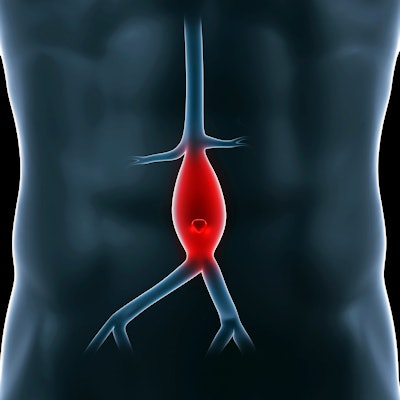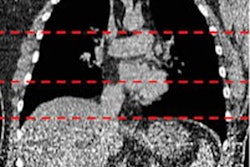
Combining CT body composition analysis with systemic inflammation data helps predict outcomes in patients undergoing elective intervention for abdominal aortic aneurysm (AAA), according to a study published June 27 in the Journal of Vascular Surgery.
The findings may improve how patients with AAA are managed, wrote a team led by Nicholas Bradley of the University of Glasgow in Scotland.
"The results of [our] study highlight the independent prognostic association of body composition and systemic inflammation in patients undergoing elective intervention for AAA," Bradley's group noted.
Identifying patients who would benefit from elective treatment procedures for AAA -- which include open surgical repair or endovascular aneurysm repair -- and assessing the risk of poor outcomes can be tricky, the team noted. Research has suggested that a combination of CT-derived body composition analysis and systemic inflammation-based scoring information (calculated by the systemic inflammatory grade, or SIG) may help clinicians predict surgical intervention outcomes in patients with AAA.
"Optimal prognostication in patients undergoing elective intervention for AAA is a clinically relevant and important area for service improvement," Bradley and colleagues wrote.
Bradley and colleagues conducted a study that included 611 patients undergoing elective treatment procedures for AAA who had elevated CT-sarcopenia scores (CT-SS) and elevated systemic inflammatory grades. CT-sarcopenia scores range from 0 to 2, with parenchymal opacification at 0%, less than 50%, or equal to or more than 50%; systemic inflammatory grades also measured on a scale of 0 to 2. All patients had CT body composition exams; the team analyzed these imaging results using CT-sarcopenia scoring and calculated SIG from preoperative blood tests. Primary outcomes of the study were overall and five-year mortality.
The group found that older age and elevated CT-SS and SIG scores were independently associated with increased risk of death and that mean survival in the CT-SS 0 and SIG 0 groups was 92.6 months compared with 44.9 months in the CT-SS 2 and SIG equal to or greater than 2 groups (p < 0.001).
It also found the following regarding five-year survival predicted by the combination of CT-SS and SIG measures:
| 5-year survival rates in patients undergoing intervention for AAA | ||||
| SIG value | CT-SS 0 | CT-SS 1 | CT-SS 2 | p-value |
| 0 | 90% | 77% | 66% | 0.01 |
| 1 | 83% | 66% | 73% | 0.51 |
| 2 | 79% | 66% | 34% | 0.01 |
These conclusions show promise for developing better care for patients with AAA, according to the team.
"[Our study results] describe a potential novel prognostic role for CT-BC and SIG in patients with AAA undergoing elective intervention," the authors wrote. "The use of these measures to identify patients at a high risk of poor outcome may allow for the development of targeted therapies, or expectant management of certain high-risk groups."
The complete study can be found here.




















